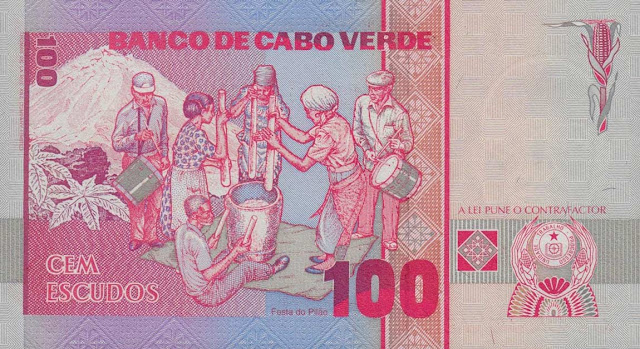Currency of Cape Verde 100 Escudos banknote 1989 Amilcar Cabral
Bank of Cape Verde - Banco de Cabo Verde
Dominating the front’s composition and occupying approximately two thirds of the note and leaning to the right, there’s the effigy of Amilcar Cabral, the founder of Cape Verdean nationality. This effigy is flanked to the left and right by a drawing of "Pano d’obra Bicho Antigo," made in Tarrafal, Santiago Island.
In the upper left corner, there’s the stylization of an ear of corn, one of the elements of the Cape Verde escudo, which coincides with the same element – by transparency – on the back of the note.
Also in the upper left corner and immediately after the ear of corn, there’s the series number, consisting of figures which are differentiated and aligned horizontally.
In the other third, and in the upper right corner, there’s an ear of corn, one of the elements of the Cape Verde Escudo, which appears on a 1.2 mm thick silver band.
The illustration on the back of the note carries the caption Festa do Pilão, which translates as the "Festival of the Pestle". The island of Fogo (São Filipe) has a distinctive music known as pilão (similar to batuko), where the chanting and beating of drums forms the background to the grinding of corn with pestles. This ‘Festa’ is held in April each year, in the period prior to the festival of Bandeira de São Filipe (Flag of São Filipe). The volcano of Mount Cano is in the background of the illustration on the back of the note.
In the same third part, beyond the watermark with the effigy of Amilcar Cabral and above the silver band, there’s the text “A Lei Pune o Contrafactor”.
Watermark: Amilcar Cabral.
Dimensions: 122 x 67 mm.
Predominant Color: Red
Cape Verde Banknotes - Cape Verde Paper Money
20.01.1989 "Amilcar Cabral" Issue
It is not known when the second series of notes was introduced, but it was almost certainly during 1989. The date on the notes is once again the anniversary of the death of Amilcar Cabral and National Heroes Day—20 January 1989. There are five denominations in this series—100, 200, 500, 1000 and 2500 escudos—and while each note in the series shares a common design, there are distinct elements for each denomination.
The front of each note is dominated by a portrait of the mature Amilcar Cabral, but each note is of differing sizes, colours and incorporates different patterns. Common to each note are the watermark of Amilcar Cabral (a copy of the illustration on the front of the notes), the clear micro-printed security thread (with the micro-printing reading ‘BCV’ for Banco de Cabo Verde), the national emblem (on the back of the notes), a perfect registration device of a cob of corn, micro-printing of ‘BANCODECABOVERDE’, and fluorescent features. The fluorescent features on the front of the notes are the right-hand serial number, which fluoresces in gold, the left-hand serial number, which fluoresces in green, and the security thread that fluoresces in blue-green.
To the immediate left of the portrait of Amilcar Cabral on each note is a pattern based on old Pano d’obra (traditional strip-woven cloths) made in Tarrafal, on the island of Santiago. Each denomination has a different pattern based on a cloth constructed by classically designed narrow-strip-weave textiles. A square of the distinctive pattern is also used as a perfect registration device for each denomination, appearing beneath the signature of the governor of the bank. The cloth pattern on each note also contains a latent image, consisting of ‘BCV’ and the denomination of the note.
On the back of the notes, viewed in portrait format, is a five-pointed star wrapped in a semi-circular scroll holding Banco de Cabo Verde and the denomination written above and below the insignia. Various inks on the back of each note also fluoresce. The notes are signed by General Pedro Verona Rodrigues Pires, the Minister of Finance, and Amaro Alexandre da Luz, the Governor.
The notes of this series were printed by Thomas De La Rue and Company.

